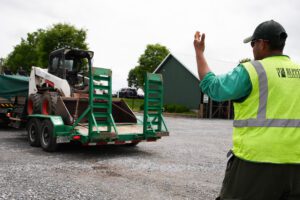 By John Tagliaferri, Regional Safety Manager
By John Tagliaferri, Regional Safety Manager
Backing a vehicle or piece of heavy equipment might seem like a routine task, but it carries serious risks if not done carefully. Even the most experienced drivers and equipment operators can’t see everything behind them—especially in large vehicles with extensive blind spots. That’s why spotters are critical to jobsite safety.
A spotter acts as a second set of eyes and ears for the driver. Whether you call them an observer, signaler, or guide, the spotter’s job is to help the driver navigate safely—especially when reversing. They stand outside the vehicle, where they can see blind spots, scan for pedestrians or obstacles, and communicate clearly with the driver.
 Backing incidents are more common than you might think. While drivers spend less than 1% of their driving time in reverse, backing accounts for about 25% of all collisions—and for fleet drivers, that number can be as high as 50%. Blind spots, poor visibility, and distractions all increase the risk of backover incidents, where a vehicle strikes a person, often with tragic consequences.
Backing incidents are more common than you might think. While drivers spend less than 1% of their driving time in reverse, backing accounts for about 25% of all collisions—and for fleet drivers, that number can be as high as 50%. Blind spots, poor visibility, and distractions all increase the risk of backover incidents, where a vehicle strikes a person, often with tragic consequences.
That’s why our #1 rule is simple: Never back up unless you know exactly what’s behind you.
Key situations where a spotter should always be used:
- When backing large trucks or equipment with obstructed views or no back-up alarms
- In congested or tight worksite areas
- When visibility is limited, such as during poor weather or low-light conditions
- Near overhead power lines or excavations
- Anytime a driver feels additional assistance is needed
Best Practices for Spotters and Drivers:
- Have a plan – Before backing begins, both driver and spotter must agree on signals and the process.
- Stay in sight – Spotters must remain visible in the driver’s mirrors at all times. If the driver loses sight of the spotter, they should stop immediately.
- Use standard hand signals – Consistent communication is critical. Hand signals should be clear, and verbal cues used only as a supplement.
- Inspect the area first – Drivers should always walk around the vehicle to check for hazards before backing.
- Move slowly and cautiously – The vehicle should always be operated at a speed that allows it to stop immediately if needed.
- Avoid dangerous positioning – Spotters should never stand between a vehicle and an object, including trailers, and should not cross from one side of the truck to the other while spotting.
At Ruppert, preventing backing accidents starts with training, retraining, and strict enforcement of safe backing policies. Remember: your safety and the safety of those around you depend on doing it the right way—every time.
Thanks for working safely—and always use a spotter!